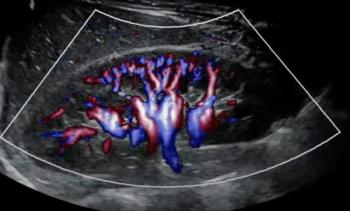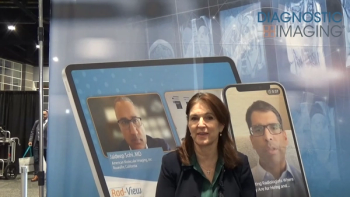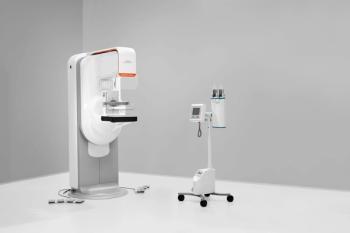
Clinicians weigh 64-slice CT's revolutionary potential
The first announcements came at the 2003 RSNA meeting, informing the radiology community that 64-slice CT would soon be available for clinical practice. Initial site installations by Siemens Medical Solutions and GE Healthcare began shortly after, in late spring and early summer of 2004. The introduction of this new technology came as a surprise to many, since 16-slice CT had been widely available only since 2002.
The first announcements came at the 2003 RSNA meeting, informing the radiology community that 64-slice CT would soon be available for clinical practice. Initial site installations by Siemens Medical Solutions and GE Healthcare began shortly after, in late spring and early summer of 2004. The introduction of this new technology came as a surprise to many, since 16-slice CT had been widely available only since 2002.
Radiologists began to wonder if this new generation of scanners would be truly revolutionary or simply evolutionary. Our early experiences have encouraged us to examine the directions we think 64-slice CT will take in the near term. Although all the major CT vendors-GE, Philips, Siemens, and Toshiba-have installed at least one 64-slice CT scanner, we have used only the Siemens Sensation 64 scanner, and our discussion of technical features will focus on that system. Our review of the clinical potential and applications of 64-slice CT technology, however, is not vendor-specific.
The introduction of 16-slice CT addressed many of the challenges and limitations present in quadslice CT scanning. Sixteen-slice CT provided for routine subsecond scan rotation times (usually around 0.5 sec), routine submillimeter slice acquisition parameters (usually 0.5 to 0.75 mm), and true isotropic data sets. Combining these scanning parameters with the ability to reduce long acquisition times and problems with tube heating meant that multislice CT had met most of the challenges of true CT volume imaging. Not surprisingly, clinical applications also evolved to take advantage of these technical advancements in three main areas:
- Classic applications such as evaluation of the liver, pancreas, and kidneys could be done with improved scan protocols, leading to better detection of disease, more accurate staging, and improved patient management.
- Vascular applications commonly referred to as CT angiography could be expanded now that true isotropic volume acquisitions were possible, overcoming the limitations of quadslice CT.
- New applications such as coronary CT angiography and peripheral runoff studies, although attempted at select institutions with quadslice CT, became practical routine applications.
Although 16-slice CT soon became the accepted gold standard for CT imaging, the ability to combine fast acquisition with properly timed injection rates and isotropic resolution still faced certain inherent limitations, especially with applications such as coronary angiography or functional imaging. Thus, researchers immediately began to look to the next generation of scanners, which could improve on experience with 16-slice CT.
In times of rapid changes in scanner technology, it is not surprising that each manufacturer regards its product as a superior one that will provide the user with the optimal scanning environment. Two of the leading CT scanning vendors for the past two decades, GE and Siemens, have introduced and installed 64-slice scanners for clinical use in the U.S. and, in Siemens' case, Europe and Japan. Although both machines are defined in the generic sense as 64-slice scanners, the vendors point out some important differences that they consider key differentiators.
Since the number of installations is small and the winner or winners cannot be determined, we asked both vendors to define the attributes of their product from a technical perspective. We will not try to compare claims of superiority, but hope to clarify the performance of each system and let the test of time show the advantages. As noted, these parameters are provided by the manufacturers and not the authors.
The Siemens Sensation 64 scanner, through its new z-sampling technology, delivers < 0.4-mm isotropic resolution for pitch values up to 1.5 in routine studies, even at isocenter, without spiral artifacts. This is achievable at a coverage speed of up to 87 mm/sec. This speed is calculated using the best resolution, which is 0.4 mm, and by setting pitch to 1.5 and the feed/second at 0.33-sec, rotation time = 1.5 x 19.2/0.33 = 87 mm/sec. The 19.2 mm is calculated by a feed per rotation of 32 x 0.6 mm. Although the Siemens 64-slice system has 32 detector elements in the center of the assembly, it has a 64-slice data acquisition system behind those detectors. The new z-sampling scheme and this detector assembly enable the simultaneous readout of two projections. The detector readout of two times 32 slices for every viewing angle enables full 64-slice acquisition. The scanner has a rotation speed of 0.33 sec, which provides unique protocol possibilities that will have an impact across a range of applications.
The GE LightSpeed VCT scanner has 64 rows of 0.625-mm detectors. At a pitch of just under 1 (63/64 = 0.984), with 40 mm of full-resolution coverage, it will scan 39.38 mm per rotation with the same or better z-axis resolution as the LightSpeed 16, 0.36 mm as measured by IMPACT. The GE detector elements are essentially square (0.625 x 0.6 mm) at isocenter, and the scanner is intrinsically isotropic. LightSpeed VCT will have an optional 0.35-sec rotation. GE also claims that in cardiac-gated mode, the scanner can do a 12 to 15-cm cardiac acquisition in five to six seconds. On the LightSpeed VCT, in high-resolution mode (64 x 0.625 mm), the anatomic coverage is 40 mm per rotation. At 1:1 pitch and 0.37-sec rotation, this corresponds to 108 mm/sec.
CLINICAL APPLICATIONS
Now that we have obtained these amazing scan parameters, the question becomes what the impact will be in clinical practice. We all experienced the revolutionary changes of 16-slice CT over quadslice but wonder whether 64-slice CT will spark a similar revolution. Although we are very early in the game, the answer is a resounding yes, no, and maybe. The path of 16-slice CT offers insight into the possible path of 64-slice CT.
There is little doubt that 16-slice CT is an impressive piece of technology. Even though it was developed and introduced into clinical practice only two years ago, most institutions have seen a double-digit growth of body CT scanning because of its capabilities.
At Johns Hopkins, our body CT scan volume increased over 20% in the last fiscal year, but the 3D/CTA volumes increased more than 40%. These numbers are not surprising to anyone who has witnessed CT's transformation into the physical examination of the 21st century. CT has replaced a range of other studies and is rapidly becoming the primary noninvasive vascular imaging study. But we recognize that as good as 16-slice CT is, definite limitations persist. These include speed of acquisition, image resolution, and image noise and artifact for select applications. This is where 64 will become the de facto standard. Yet most institutions will likely use a combination of 16- and 64-slice scanners in their clinical practice.
No doubt, the most exciting application for 64-slice CT is coronary artery and cardiac imaging. With 16-slice CT, we began doing coronary CTA. But even with the use of beta blockers, the study success rate was adequate in only 80% of patients. The problems related to a combination of acquisition time and slice thickness, or what might be described as temporal and spatial resolution. With 64-slice CT, we are able to use cardiac gating and acquire a data set in as little as five to seven seconds, or a few heartbeats.
The ability to visualize the coronary arteries in unprecedented detail without motion artifact is the promise that 64-slice CT brings. Acquisition of 4D data provides studies of cardiac motion, cardiac function, and valve function. The use of fast scanning also allows sequential imaging of the myocardium to look for perfusion changes of early myocardial infarction. Many centers are beginning to develop protocols to look at acute coronary syndrome with 64-slice CT as the initial, and potentially only, exam. If successful, this approach will revolutionize care in the emergency room and lead to changes in the management algorithm for millions of ER patients every year.
Vascular imaging beyond the heart and coronary arteries will also benefit from 64-slice technology. Two specific applications are evaluation of the carotid artery and peripheral runoff studies. Both have faced limitations with prior technologies. Carotid imaging-when done from the aortic arch through the base of the skull or even through the circle of Willis-was often degraded by rapid venous contamination. Although the use of editing tools, clip planes, and volume rendering made these studies possible, 64-slice technology will allow an acquisition fast enough to avoid venous contamination.
In peripheral studies, two issues are the timing of the bolus transit and whether this should be done at the aorta or popliteal vessels. Both strategies have faced limitations. With the 64-slice scanner, the scan can be monitored until contrast appears in the lower legs, triggering acquisition. This will potentially limit venous contamination caused by scanning too late or inadequate enhancement due to scanning too early.
Similarly, a 64-slice system with higher spatial and temporal resolution will no doubt provide better data sets for routine imaging, ranging from evaluation of suspected liver metastases and staging of renal tumors to detection of pulmonary embolism. Yet 16-slice CT is so good that improvement in sensitivity and specificity might be limited if a traditional approach accompanies the shift to 64-slice imaging. We expect 64-slice CT to result in a new paradigm. We will move from purely structural imaging of normal anatomy and pathology to a more functional approach. Functional or physiologic imaging not only detects discrete lesions per se but also recognizes increases or decreases in vascular flow.
To date, most functional CT imaging has targeted the brain, with varying success. In some institutions, it is a critical part of stroke imaging. But organ enhancement often is a result of a range of factors that go far beyond the presence of a discrete lesion or vascular invasion by a mass. Rather, functional flow changes may occur on a microscopic level where no detectable tumor mass is seen. Early changes on a vascular level due to tumor may result in changes in perfusion that could suggest the presence of early disease. Previously, articles have suggested that changes in liver perfusion may be a good indicator of future metastatic disease. In addition, flow-related changes in a kidney or liver mass may help define the degree of angiogenesis in a tumor and guide surgical management. We also think that perfusion may be a way to look for early pulmonary embolism, taking advantage of both visualization of the pulmonary arteries and lung perfusion, thereby matching some of the attributes of traditional lung perfusion scanning with nuclear medicine studies.
With development of new agents for PET scanning or even with current agents, a combination of perfusion mapping may go a long way to support continuing understanding of tumor activity and recurrence patterns using PET.
FURTHER DEVELOPMENT
The introduction of 64-slice CT could suggest that all of our limitations with CT have been solved, and, as Charles H. Duell, U.S. commissioner of patents in 1899, said, "Everything that can be invented has been invented." In fact, nothing is further from the truth. Sixty-four-slice CT is but one step leading to area detectors, with which a scan of the heart or liver might be done in less than a heartbeat. The era of 64-slice CT creates new issues, reminding us of a combination of Richard Nixon's "Solutions are not the answer" and Eric Sevareid's "The chief cause of problems is solutions."
Radiologists are already concerned about network transfers, archiving, and retrieving of 16-slice CT data sets, which run in the 400 to 1200-slice range for most CTAs. What will they do with two to three times that number of slices from 64-slice CT? That challenge must be addressed. In addition, workstations have been upgraded in recent years with special processing boards to interactively render 1000 or more slices. But can they handle 3000 to 5000-slice data sets? What about the load time for these data sets on a workstation?
Radiologists and referring physicians are now becoming comfortable with volume visualization as a primary reading and review mode. But they are not willing-nor should they be willing-to wait 10 to 15 minutes for a data set to load. Storage of data on central servers as well as retrieval of data will become enterprise-wide issues that require solutions. Success in solving the backbone issues will go a long way toward ensuring the success of 64-slice CT. Surmounting the challenges to efficient workflow is critical if 64-slice CT is to reach its full potential.
We are confident that these problems and others will be overcome through careful collaboration between industry and academia. This approach should include radiologists, technologists, referring physicians, computer scientists, and design specialists. New models will evolve, and the radiologist must lead, rather than react to, this change.
The advent of 64-slice CT will probably lead to the implementation of an imaging workflow that truly incorporates volume visualization into routine practice. It has taken almost 20 years to get to this point. We are anxious to see what the next two years will bring.
Dr. Fishman is a professor of radiology and director of diagnostic radiology and body CT, and Dr. Horton is an associate professor of radiology, both at Johns Hopkins Hospital in Baltimore; Dr. Anders is a radiology resident, and Dr. Achenbach is an assistant professor of radiolgy, both at the University of Erlangen in Erlangen, Germany.
Newsletter
Stay at the forefront of radiology with the Diagnostic Imaging newsletter, delivering the latest news, clinical insights, and imaging advancements for today’s radiologists.




























